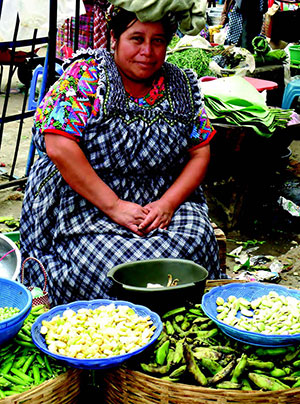Authors: Heather Danton, Director, Food Security and Nutrition; Alyssa Klein, Food Security and Nutrition Specialist, SPRING
Introduction: The effect of agriculture on nutrition is multifaceted. Agriculture—
- contributes to a healthy life by producing foods for household consumption and increasing availability of foods within local markets
- increases income for producer households, which enables the purchase of more diverse food and may leverage greater access to and diversity of healthy foods in local markets
- affects the status of women in producer households since health is impacted by a woman’s time use, energy expenditure, and control over household income.
Yet the agriculture sector encompasses a far greater sphere than agriculture producer households; it comprises people and institutions that are involved in the consuming, disposing, marketing, processing, and producing of food.
Opportunities to enhance nutrition-sensitivity can exist at each stage of the value chain and food system.
Key Stages of an Agricultural Commodity Value Chain and Food System


Nutrition-sensitive interventions address the underlying determinants of malnutrition:
- access to health services
- access to caregiving resources
- food security
- a safe, hygienic environment.
Methodology: SPRING examined two USAID-funded export-oriented value chain activities in Guatemala (Asociación Guatemalateca de Exportadores [AGEXPORT], and the Asociación Nacional del Café [ANACAFE]) to better understand how and where linkages to nutrition may be leveraged within agricultural value chain programming.
The study focused on a qualitative review of three commodity value chains (coffee, green beans, and handicrafts).
Results: The findings revealed opportunities to incorporate nutrition-sensitive agriculture thinking and interventions in these areas for the Guatemala programs:
- Technologies like drip irrigation and greenhouses could improve resiliency, increase productivity, and save time and/or energy of producers.
- Production methods like improved water and soil management could lead to increased income and to decreased time and labor demands by mitigating erosion and maintaining nutrients in the soil and crops.
- Bulk drying and pulping of coffee during wet seasons could decrease waste caused by fermentation and waste-water runoff into local streams. This runoff pollutes water sources that are used for household consumption.
- Marketing and retailing practices could expand and diversify the number of domestic and international buyers to improve farmers’ bargaining power and reduce producers’ risk.
- Expanded messaging could improve consumption and feeding practices, especially among households with children. Producer cooperatives, processors, and other businesses operating within any given value chain could facilitate the establishment of practices that maximize women’s time and enhance their ability to care for very young children. For example, businesses could provide on-site childcare services as well as time and space for breastfeeding infants and feeding young children.
- Safe disposal of agricultural waste materials, such as empty pesticide containers, could help deter communities’ use of pesticide-contaminated containers to store drinking water or food, which would improve residents’ health.

Conclusion: Opportunities exist for improving the nutrition sensitivity of any value chain, regardless of the commodity’s nutritional content. The underlying determinants of undernutrition—food, health, and care—may be useful for identifying leverage points where value chains can better contribute to positive nutritional outcomes among producers and in target communities.
Good agriculture practices can be nutrition-sensitive and can yield—
- increased production of diverse foods
- improved soil and environmental health
- increased incomes for male and female producers
- more time available for mothers to spend caring for their families.
As part of program design, stakeholders should consider identifying nutrition-sensitive actions to be performed by the range of actors within any target value chain, from input suppliers to processers and buyers. This will strengthen the enabling environment for nutrition, ensuring that agriculture does no harm and instead contributes to improved food, health, and care.
